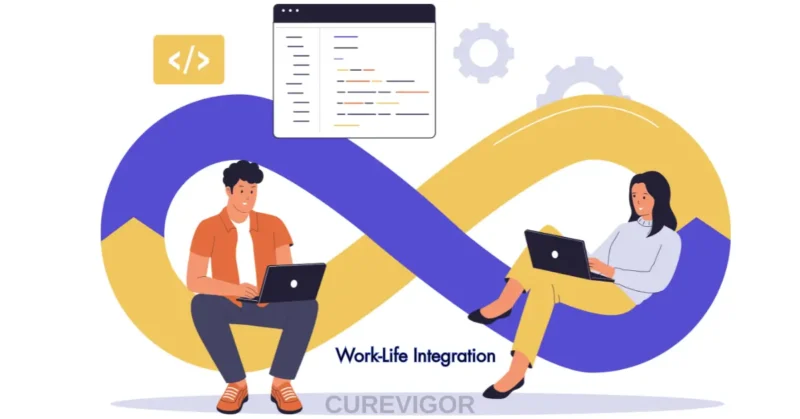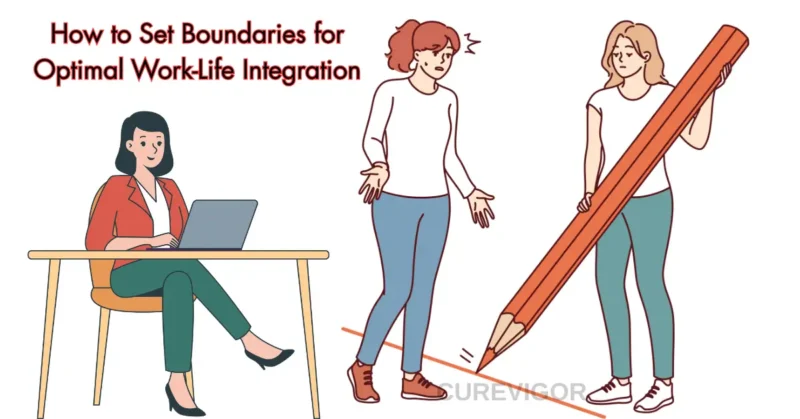Master Work-Life Integration by learning to set clear boundaries. This essential guide provides steps to prevent burnout, manage your time effectively, and prioritize self-care.
Thank you for reading this post, don't forget to subscribe!Create a harmonious blend of work and life that actually works for you.
You finish dinner. You tuck the kids into bed. You finally sit on the couch, ready to relax. Then, you hear it. A soft ping from your phone. It’s a work email.
A quick one. You could answer it now. “Just one more thing,” you tell yourself. “It’ll only take a minute.”

Sound familiar? This “just one more” mentality is the silent killer of modern professional life. We live in an era of constant connectivity.
The dream of seamlessly blending our careers and personal lives, what we call Work-Life Integration, has become a stressful reality of blurred lines. The office is now in our pockets. The workday never truly ends.
This post is not about creating a perfect, rigid balance. It is about building a sustainable, healthy blend. We will learn the hidden dangers of poor integration.
You will get a practical blueprint to set powerful boundaries. You will also learn how to protect your well-being and reclaim your time. Let’s dive in.
The Blurred Lines of Work-Life Integration

Work-Life Integration is the modern approach to managing professional and personal responsibilities.
It acknowledges that a strict 9-to-5 separation is often unrealistic. Instead of a perfect scale, it aims for a harmonious blend. Work and life flow together throughout the day.
This model offers fantastic flexibility. You can attend a school play in the afternoon. You can make up the work later that evening. In between meetings, you can do a lot of washing.
The problem arises when the blend becomes a takeover. Work consistently bleeds into family time, personal hours, and sleep. The integration becomes an invasion.
The “always-on” culture fuels this fire. Laptops are open on the kitchen counter. Slack notifications buzz during date night. The expectation to be perpetually available creates a low hum of anxiety.
Your home ceases to be a sanctuary. It becomes a satellite office. Recognizing this blur is the first step toward fixing it.
The Risks of Poor Work-Life Integration
Ignoring the blur has serious consequences. It impacts your health, your happiness, and your relationships. Let’s break down the real costs of failing to set boundaries.
Burnout and Exhaustion: The Consequences of Overwork
Burnout is more than just feeling tired. It is a condition of mental, physical, and emotional tiredness brought on by extended stress.
It is categorized as an occupational phenomenon by the World Health Organization.
Chronic overwork depletes your energy. You wake up already feeling tired. Your motivation plummets. Tasks that used to be simple feel monumental. This state leads to a cruel irony: you work more hours but accomplish less. Your creativity and problem-solving skills suffer.
Poor Work-Life Integration creates a vicious cycle of declining productivity and rising fatigue.
Your physical health pays the price, too. Constant stress can lead to:
- Weakened immune system
- High blood pressure
- Sleep disturbances
- Digestive issues
Your body sends signals. It is crucial to listen before a major breakdown occurs.
Strained Relationships: The Impact on Personal Life
When work consumes your attention, your personal life withers. Your partner feels ignored. Your children notice your distracted presence. Friends stop inviting you out because you’re always “busy.”
You may be physically present at the dinner table, but your mind is in your inbox. This “phubbing” (phone snubbing) erodes connection.
It sends a silent message that work is more important than the people in front of you.
Over time, this breeds resentment and loneliness. It undermines the very relationships that make life fulfilling.
Strong relationships require presence and time—two things that poor Work-Life Integration steals. Protecting these connections is not a luxury. It is a necessity for a whole and happy life.
Setting Boundaries for Optimal Work-Life Integration

The solution to this modern dilemma is not to quit your job. It is to build strong, intentional boundaries. Boundaries are not walls.
They are the gates that control the flow between your work and personal life. They protect your time, your energy, and your relationships.
Learn to Say No: Setting Healthy Boundaries
“Saying no” is a superpower. It protects your priorities. Many people fear that saying no will make them seem uncooperative or lazy.
In reality, it demonstrates professionalism and self-respect. It shows you understand your limits.
How can you start?
- Clarify Your Priorities: Know what is non-negotiable for you. Is it a family dinner? Your weekly yoga class? Your eight hours of sleep? When you know what you value, it becomes easier to protect it.
- Communicate Clearly: You do not need a long excuse. Try phrases like, “I can’t take that on right now, but I can look at it first thing tomorrow morning,” or “I have a personal commitment during that time.”
- Manage Expectations: If you typically answer emails at 10 PM, people will expect you to always be available at 10 PM. Break the cycle by setting a cut-off time and sticking to it.
Setting boundaries is a skill. It feels uncomfortable at first. With practice, it becomes the foundation of sustainable Work-Life Integration.
Prioritize Self-Care: Making Time for Personal Activities
Self-care is often dismissed as a buzzword. It is, in fact, a critical component of productivity and stress management. You cannot pour from an empty cup. Making time for activities that recharge you is not selfish. It is strategic.
Self-care looks different for everyone. It could be:
- Reading a book for 30 minutes
- Going for a run
- Cooking a nice meal
- Meditating
- Meeting a friend for coffee
Schedule these activities in your calendar. Treat them with the same importance as a business meeting.
When you prioritize your well-being, you show up as a better employee, partner, and parent. This is a core principle of effective Work-Life Integration.
Strategies for Achieving Work-Life Integration
Knowing you need boundaries is one thing. Implementing them is another. These effective techniques can help you establish a framework that fosters a healthy work-life balance.
Flexible Work Arrangements: Creating a Schedule That Works
If your company allows it, take advantage of the flexibility. A rigid schedule may not be the best fit for your life. Speak with your manager about options that will benefit both you and the company.
- Compressed Workweek: Work longer hours for four days to get a three-day weekend.
- Flextime: Start and end your day earlier or later to accommodate school runs or gym sessions.
- Remote/Hybrid Work: Eliminate a long commute. Use that saved time for personal pursuits or deep work.
The aim is to create a work plan that fits your personal obligations and natural rhythms. This proactive approach is key to mastering Work-Life Integration.
Time Management: Prioritizing Tasks and Managing Time
Effective time management is the engine of good Work-Life Integration. When you work efficiently, you get more done in less time. This reduces the urge to work late or on weekends.
- Blocking time: Set aside specified time slots for various tasks. Block time for deep work, meetings, email, and personal activities. This creates a visual map of your day and prevents tasks from spilling over.
- The Pomodoro Technique: Work in focused, 25-minute sprints followed by a 5-minute break. This method helps fight procrastination and keeps focus levels high.
- The “Eat the Frog” Method: Tackle your most challenging task first thing in the morning. This creates momentum and prevents the task from hanging over you all day.
By taking control of your time, you reduce stress and create clear stopping points for your workday.
Maintaining Work-Life Integration Boundaries
Setting boundaries is a great start. Maintaining them is the real challenge. It requires consistent communication and a healthy dose of self-compassion.
Communicate with Your Team: Setting Expectations
Your colleagues cannot respect boundaries if they are not aware of them. Clear communication is essential.
- Set Communication Guidelines: Use your email signature or Slack status. Indicate your working hours. Let people know when they can expect a response if they message you outside of those times.
- Utilize “Do Not Disturb.” Turn off work notifications on your phone after hours. Use the “Focus” or “Do Not Disturb” features. This simple act creates a powerful psychological barrier.
- Have a Conversation: Discuss your plan for improved work-life integration with your manager and team. Frame it as a way to increase your focus and productivity during work hours. Most reasonable people will support this.
Practice Self-Compassion: Being Kind to Yourself
You will not be perfect. There will be weeks when a big project requires extra hours. You might check your email during family time. That is okay. Burnout prevention is a journey, not a destination.
When you slip up, do not berate yourself. Practice self-compassion. Acknowledge the misstep. Understand why it happened.
Then, gently recommit to your boundaries. Beating yourself up only adds more stress. Be as compassionate with yourself as you would be with a friend.
FAQs
Q. How to set boundaries in work life?
Setting boundaries at work begins with self-awareness. Identify what stresses you, like late-night emails or constant meetings. Communicate your limits clearly and confidently to your team and manager.
For instance, state you won’t answer emails after 6 PM. Utilize technology to enforce these rules; turn off notifications and set an “out of office” reminder after hours. Remember, consistency is key.
Uphold your boundaries firmly, even when it feels uncomfortable, to train others to respect your time and prevent burnout.
Q. What are the 4 C’s of boundaries?
The 4 C’s provide a robust framework for establishing effective personal limits. Clarity involves knowing what you need and explicitly stating it.
Communication is about expressing these boundaries assertively and without apology.
Consistency means applying your rules uniformly, so others learn to trust and respect them.
Finally, Consequences are the actions you take if a boundary is repeatedly crossed, which might include limiting contact or re-evaluating a relationship.
Together, these four pillars create strong, understandable, and enforceable boundaries.
Q. What are the 3 C’s of boundaries?
A simpler, powerful model for boundaries is the 3 C’s. First, be crystal clear in your own mind about your limits and needs.
Second is Communication: you must articulate these boundaries to others in a direct, respectful manner. The third and often most challenging C is Consistency.
You must consistently uphold your boundaries for them to be taken seriously. Inconsistent enforcement sends mixed signals and undermines your efforts, making it easy for others to overlook your stated limits.
Q. What is the 8 8 8 rule work-life balance?
The 8-8-8 rule is a simple, memorable formula for a balanced day. Divide your 24 hours into three segments: 8 hours for work, 8 hours for personal time, and 8 hours for sleep.
This framework champions the idea that each aspect of life deserves dedicated, uninterrupted time. It challenges you to protect your 8 hours of personal time for hobbies, family, and self-care as fiercely as your work hours.
While idealistic, it serves as an excellent benchmark for evaluating and improving your daily structure.
Q. What are the 4 stages of boundary development?
Establishing healthy boundaries is a process that unfolds in four key stages. It begins with Discovery, where you reflect on your needs and identify where limits are necessary.
Next is Preparation, where you plan what to say and how to communicate your boundary. The third stage is Implementation, the action step of clearly and calmly stating your new limit.
The final, ongoing stage is Maintenance, which involves upholding the boundary, managing pushback, and adjusting it as needed over time. This is a cyclical, not linear, journey of personal growth.
Q. How do you maintain your boundaries in three easy steps?
Maintaining boundaries can be distilled into three actionable steps. First, Rehearse Your Script. Have a simple, go-to phrase ready, like, “I can’t take that on, my plate is full.” Second, Schedule Your Defense.
Use calendar blocks for personal time and set “Do Not Disturb” modes on your devices to automatically protect your space.
Third, Conduct a Weekly Review. Each week, ask yourself where your boundaries were tested and how you can reinforce them. This proactive habit ensures your limits evolve as your needs change.
Your Integration, Your Rules
The goal of Work-Life Integration is not to perfectly segment your life. It is to create a fluid, sustainable blend where both work and personal life can thrive without constantly competing. It is about being present wherever you are.
The hidden danger of “just one more” is the slow erosion of your well-being. By setting clear boundaries, prioritizing self-care, and managing your time effectively, you reclaim control. You move from being reactive to intentional.
Start small. Choose one boundary to implement this week. Maybe it’s a digital shutdown at 7 PM. It might be a good idea to schedule some time for a walk during lunchtime.
Every step counts. Your career is a marathon, not a sprint. Your life is happening now. Do not let “just one more” thing steal it.
Read more articles on Health and Balance.
You might like:




